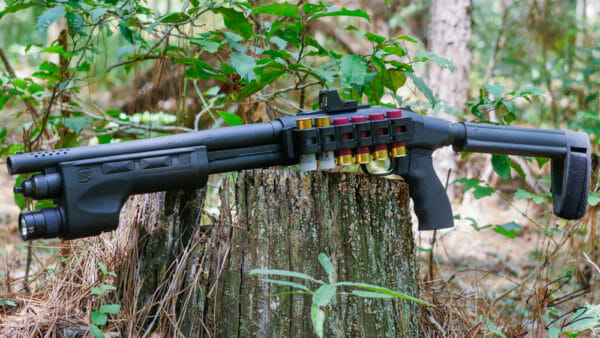
WASHINGTON, D.C. -(Ammoland.com)- The Bureau of Alcohol, Tobacco, Firearms and Explosives (ATF) new final rule surrounding pistol stabilizing devices has spurred a debate on the internet about what is and is not allowed. The source of the confusion seems to be the proposed rule was included within the document released by the Bureau. This confusion has led some people to believe the ATF will not allow imported pistol to be registered and revokes all letters for pistol grip shotguns.
The ATF has assured AmmoLand News that pistol grip shotguns that fall outside the scope of the National Firearms Act (NFA) but are considered short-barreled shotguns (SBSs) under the Gun Control Act of 1968 (GCA) are not affected by ATF final rule 2021R-08F that regulates pistol stabilizing braces. The GCA and NFA have slightly different definitions of Shot Barrelled Shotguns. This discrepancy has developed a grey area where not all SBS are considered NFA firearms. These guns include items such as the Remington TAC-14 and the Mossberg Shockwave.
AmmoLand News contacted the ATF and spoke with Public Affairs Division Deputy Chief Erik Longnecker about pistol-gripped shotguns with barrels less than 18 inches. Other sources have reported that the ATF has revoked all prior classification letters. On page 47 of the published comments section submitted with the Final Rule, it seems to indicate that these shotguns are no longer legal.
“As discussed in section II.B of this preamble, these firearms are specifically designed to be fired with two hands. ATF has always classified these weapons as ‘firearms’ under the GCA and not as ‘shotguns,’ because they do not incorporate a shoulder stock and are not designed and intended to be fired from the shoulder like a shotgun. Nor has ATF classified these weapons as ‘pistols,’ as they are not designed to be held and fired in one hand like a pistol. Thus, the addition of a ‘stabilizing brace’ does not assist with single-handed firing, but instead provides surface area that allows for firing from the shoulder. Therefore, a ‘pistol grip shotgun’ equipped with a ‘stabilizing brace’ and a barrel of less than 18 inches is an NFA’ firearm,’ i.e., a short-barreled shotgun,” the rule reads.
The ATF response goes further and rejects all letters issued for these shotguns in the page 47 footnotes.
Footnote 73 reads: “As mentioned above, any classification that provides that a “pistol grip shotgun” is not an NFA firearm is no longer valid or authoritative and should be resubmitted to FATD for evaluation.”
According to Mr. Longnecker, people are misreading the Final Rule. The ATF claims that the page is from the proposed rule, not the final rule. He goes further and points to the final rule actually starting at the bottom of page 268. AmmoLand News verified Mr. Longnecker’s claim that the final rule does start on page 268.
“The final rule does not address pistol grip firearms (such as the Tac-14 or Shockwave), nor does it revoke prior classification letters relating to those firearms. Those were in the proposed rule,” Longnecker wrote.
“If you check the document, you will see that the Final rule begins at the bottom of page 268; page 47 is from the initial proposed rule. Since the document is fairly lengthy, it could be useful to use the bookmarks within the pdf, to see which sections you are in. That is helpful for me.”
If we take Longnecker, who is authorized to speak on behalf of the ATF, at his word, that means there could be a lot of misconceptions because he is insinuating that nothing above the bottom of page 268 is authoritative.
We can use that information to break down the rule. One issue that has been raised is an issue with 922(r) compliance. A rifle must have a certain quantity of American-made parts under the 922(r) regulation. The same rule does not bind pistols. Some gun groups have reasoned that if the ATF is retroactively making braced pistols short-barreled rifles (SBRs), there would be no way to bring it in line with 922(r).
Mr. Longernecker admits it is true that there is no way to bring a rifle into 922(r) after it has been assembled, but if a gun owner added a brace to a pistol after it was assembled, then according to the ATF, they could still file for their tax stamp like any other person. The ATF claims that the end user is not subject to 922(r) compliance demands.
“Section 922(r), in relevant part, makes it unlawful to assemble from imported parts a semiautomatic rifle that is otherwise not importable. The implementing regulations of the GCA at 27 CFR 478.39 provides that a person may not assemble a semiautomatic rifle using more than 10 of the imported parts listed in the relevant paragraphs of the regulation. As discussed on page 246 of the proposed rule, the criminal violation under section 922(r) is for the ‘assembly’ of the semiautomatic rifle; therefore, no modification of such firearm would cure the 922(r) violation because the ‘assembly’ has already occurred. Accordingly, a person with an imported pistol that was subsequently equipped with a ‘stabilizing brace’ will have the same options as anyone else under the final rule. Should that person choose to register the firearm, no further modification of the firearm with domestic parts is required.”
AmmoLand News tried to get answers to what the ATF recommends an end user do if they purchased a foreign-made pistol with a pistol stabilizing brace. The ATF has not responded to the question at this time. Although, it would be almost impossible for the ATF to determine when the pistol brace was added to the firearm. If AmmoLand News gets an answer, then we will update the story.
The document that the ATF released is long and not easy to understand. It will take time and effort to understand all the nuances in the document, and there will be disagreements. AmmoLand News will continue to pressure the ATF to comment, on the record, to clarify any misunderstandings. This will enable the public to hold the ATF accountable if it changes its mind about the meaning and enforcement of the Final Rule.
About John Crump
John is a NRA instructor and a constitutional activist. John has written about firearms, interviewed people of all walks of life, and on the Constitution. John lives in Northern Virginia with his wife and sons and can be followed on Twitter at @crumpyss, or at www.crumpy.com.

from https://ift.tt/GgtdYjp
via IFTTT

No comments:
Post a Comment